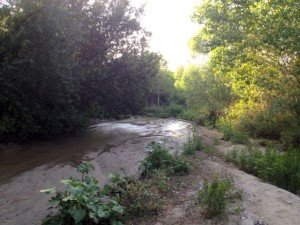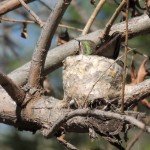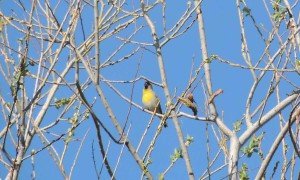The daylight’s savings time change made it harder but I’m so glad I attended the Redlands Conservancy birdwatching event this morning at San Timoteo Nature Sanctuary (click here for previous article on this special preserve in Redlands CA). Allyson Beckman, who helps monitor endangered species as a field biologist with the Santa Ana Watershed Association, shared her significant knowledge. She’s also helped usher in a success story at the preserve with the endangered Least Bell’s Vireo, a small bird whose appearance is more gray than yellow in the West. Numbers tell it best: fifteen years ago a colleague of hers documented 5 males. Last year: 151.
Here are my takeaways from Beckman’s walking talk about the local and migrant birds found in San Timoteo Canyon.
- Embrace success stories – endangered programs work. The endangered Least Bell’s Vireo should be arriving in a couple weeks from its wintering grounds in Baja, Mexico. The Vireo’s biggest threat is the Brown-headed Cowbird, whose strategy is to lay eggs in other birds’ nests. Helped by a cowbird trapping program, Beckman documented 90 nests last year and 200 babies. Five were parasitized with cowbirds eggs. Without trapping, those Vireo’s offspring wouldn’t survive. (Cowbird babies are large and demand much food.)

A female Anna’s hummingbird on her nest in a branch 10 feet above the trail - Look nearby. Right off the trail was a Bushtit nest (one of those pendulous weavings) and immediately above us was an Anna’s Hummingbird sitting on her nest. Anna’s Hummingbirds nest early and often have two broods. (Black-chinned hummers also nest here.)
- Be still for 20 minutes. When we stood not far from the creek, looking up in the trees, we saw over a half dozen species and heard more — despite several dozen of us and a noisy train going by. “Patience is important. I really recommend finding a place to sit, like around here. You’ll see many birds pass through,” says Beckman, who as a Navy kid lived in many countries and states where she always gravitated to nature and wildlife. We were rewarded with our area’s three goldfinch species (Lessers, American and Lawrence’s), a pair of Nuttall’s Woodpeckers, and Yellow-rumped Warblers, who are about to depart for their breeding territory north. Further down the trail a small flock of swallows flew by that I didn’t know, Northern Rough-winged Swallows.
- Learn to listen. This is not one of my strengths. But since 80-90% of bird connections are hearing them — versus seeing them — learning bird songs makes birding more enjoyable. For example, Beckman said it’s likely that we won’t see a Least Bell’s Vireo if we return to the preserve in the next few months. “But especially in late March through early May when the males are establishing territories and competing for mates we might hear them.” Here is the Cornell Lab of Ornithology’s website page with their song.
- We are bird-rich in our preserves. Beckman estimates San Timoteo is home to 45 to 50 different year-round resident species and about 40 migrants. Some migrants pass through on their way to breeding grounds, while others live here only part of the year.
I wrote a previous ‘Great Hikes’ post on San Timoteo Canyon’s special features.
Bird Photos: Courtesy of Wayne Price



Leave a Reply